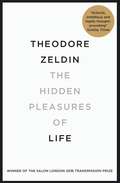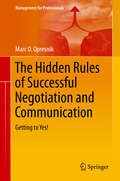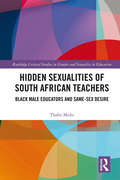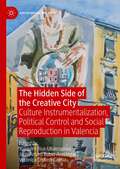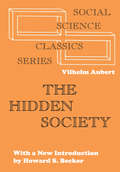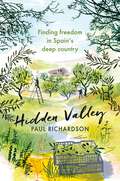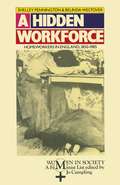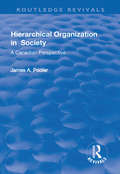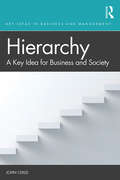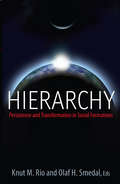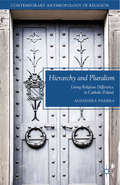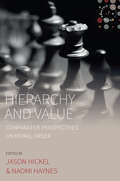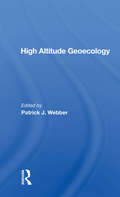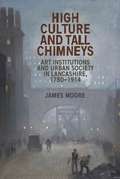- Table View
- List View
The Hidden Pleasures of Life: A New Way of Remembering the Past and Imagining the Future
by Theodore ZeldinThe story of a search for a new art of living. How can one escape from work colleagues who are bores and from organisations that thrive on stress? What new priorities can people give to their private lives? When the romantic ideal is disappointing, how else can affections be cultivated? If only a few can become rich, what substitute is there for dropping out? If religions and nations disagree, what other outcomes are possible beyond strife or doubt? Where there is too little freedom, what is the alternative to rebellion? When so much is unpredictable, what can replace ambition? Questions include: What is the great adventure of our time? What is a wasted life? How can people lose their illusions about themselves? What alternatives are there to being a rebel? What can the poor tell the rich? What could the rich tell the poor? How many ways of committing suicide are there? How can an unbeliever understand a believer? How can a religion change? How can prejudices be overcome? How can one think about the future, without trying to predict it or worrying about it? Is ridicule the most effective form of non-violent protest? How does one acquire a sense of humour? What stops people feeling completely at home in their own country? How many nations can one love at the same time? Why do so many people feel unappreciated, unloved and not fully alive? How else might women and men treat one another? What can replace the shortage of soul-mates? Is another kind of sexual revolution achievable? What can artists aim for beyond self-expression? What is more interesting than becoming a leader? What is the point of working so hard? Are there more amusing ways of earning a living? What else can one do in a hotel? What more can the young ask of their elders? Is remaining young at heart enough to avoid becoming old? What is worth knowing? What does it mean to be alive? Where can one find nourishment for the mind?
The Hidden Rules of Successful Negotiation and Communication: Getting to Yes! (Management for Professionals)
by Marc O. OpresnikNegotiations in professional or private life often take an unsatisfactory course due to stress, confrontation with aggressive or unfair behavior, or because of overwhelming situations.Negotiations generally require a thorough preparation, strategy and a sophisticated tactic to make us feel safe in the presentation of our goals and arrive at a mutually satisfactory outcome. Conventional books about negotiations are usually limited to strategies and techniques, but leave out elements of psychological communication and emotional intelligence, which include non-verbal communication and empathy, which in turn are essential for successful negotiation. Therefore, this book on the one hand constitutes the essential techniques and strategies in the context of negotiation, but also considers "soft skills" without which negotiations cannot be successful.This book presents practical examples in dealing with situations such as salary, contract and sales negotiations. In particular on context and time appropriate negotiation techniques; analyzing negotiation partners and their motives; interpret group processes, and how to successfully implement negotiation psychology.
Hidden Sexualities of South African Teachers: Black Male Educators and Same-sex Desire (Routledge Critical Studies in Gender and Sexuality in Education)
by Thabo MsibiSouth Africa remains a global leader in the legislative protection of individuals who engage in same-sex relations, and is the only country in Africa where the rights of these individuals are explicitly recognized and protected by the constitution. Yet South Africa’s identities are still contested and evolving, particularly for same-sex desiring teachers – many are forced to locate their sexualities privately for fear of being ostracized, bullied or losing their jobs, resulting in the miseducation of young people in schools. This volume reveals the various ways in which black South African male teachers construct their sexual and professional identities, how they accommodate structural dictates while simultaneously resisting them, and the effect this has on students. Presenting the day-to-day experiences of eight same-sex desiring teachers within repressive contexts, this volume challenges the Western origins and assumptions of queer theory, particularly its inability to confront communal forms of social organizing and its focus on individual agency. It asks for more socially responsive theorizing that takes into account the role played by location, race, class, gender and sexual identification within South African and international contexts.
Hidden Sexualities of South African Teachers: Black Male Educators and Same-sex Desire (Routledge Critical Studies in Gender and Sexuality in Education)
by Thabo MsibiSouth Africa remains a global leader in the legislative protection of individuals who engage in same-sex relations, and is the only country in Africa where the rights of these individuals are explicitly recognized and protected by the constitution. Yet South Africa’s identities are still contested and evolving, particularly for same-sex desiring teachers – many are forced to locate their sexualities privately for fear of being ostracized, bullied or losing their jobs, resulting in the miseducation of young people in schools. This volume reveals the various ways in which black South African male teachers construct their sexual and professional identities, how they accommodate structural dictates while simultaneously resisting them, and the effect this has on students. Presenting the day-to-day experiences of eight same-sex desiring teachers within repressive contexts, this volume challenges the Western origins and assumptions of queer theory, particularly its inability to confront communal forms of social organizing and its focus on individual agency. It asks for more socially responsive theorizing that takes into account the role played by location, race, class, gender and sexual identification within South African and international contexts.
The Hidden Side of the Creative City: Culture Instrumentalization, Political Control and Social Reproduction in Valencia (Sociology of the Arts)
by Joaquim Rius-Ulldemolins Juan Arturo Rubio-Arostegui Verònica Gisbert-GraciaThis book analyses issues related to the political use and economical misappropriation of urban cultural events, cultural infrastructures, public resources, and cultural traditions in the city of Valencia, Spain. It deals critically with a variety of sociological questions related to cultural production in the city, including geographical segregation as culturally defined in the city; misogyny and the peripheral role of women in traditional cultural events, xenophobia; and nationalism/regionalism.As such, the book will be useful to students and scholars of sociology of the arts, cultural policy, and museum management, and urban sociology.
The Hidden Society (Social Science Classics Ser.)
by J. E. MeadeSocieties consider certain institutions and activities as central, proper, and visible, while others are defined as peripheral, deviant, and private. Vilhelm Aubert takes us to the ""hidden"" societies: the privacy of love, the secrecy of the underground, the remoteness of a ship, the isolation of the ill, the retirement from social life into sleep, and similar fascinating topics.Vilhelm Aubert, a professor of sociology in the Law Faculty of Oslo University and a member of the board of directors of Oslo's famed Institute of Social Research, presents a theory of the hidden societies, a theory concerned with concepts such as time and space, causality, will, and' chance. Chapters on predictability and chance deal with lack of 6rder, with phenomena that appear meaningless or absurd from a point of view very prevalent in modern life. We are presented with a study of isolation as a sociological phenomenon - accepted or fostered by social action - and we see how the existence of lonely, private niches in a society serves, consciously or unconsciously, to satisfy-idiosyncratic needs of individual personalities.
The Hidden Society
by J. E. MeadeSocieties consider certain institutions and activities as central, proper, and visible, while others are defined as peripheral, deviant, and private. Vilhelm Aubert takes us to the ""hidden"" societies: the privacy of love, the secrecy of the underground, the remoteness of a ship, the isolation of the ill, the retirement from social life into sleep, and similar fascinating topics.Vilhelm Aubert, a professor of sociology in the Law Faculty of Oslo University and a member of the board of directors of Oslo's famed Institute of Social Research, presents a theory of the hidden societies, a theory concerned with concepts such as time and space, causality, will, and' chance. Chapters on predictability and chance deal with lack of 6rder, with phenomena that appear meaningless or absurd from a point of view very prevalent in modern life. We are presented with a study of isolation as a sociological phenomenon - accepted or fostered by social action - and we see how the existence of lonely, private niches in a society serves, consciously or unconsciously, to satisfy-idiosyncratic needs of individual personalities.
Hidden Valley: Finding freedom in Spain's deep country
by Paul RichardsonThe story of the real 'good life' of an off-grid existence in rural SpainPaul Richardson fled the city to live on the land in a rough-and-tumble village on the edge of Europe. Immersing himself in the culture of his remote Spanish community, he learned the traditional arts of animal husbandry and vegetable growing, wine-making and home distilling, and made bread from the rye he sowed on the stone-walled terraces of his twelve-acre farm. In prose that shimmers with wit and sensuality, the author charts his personal route-map along a road less travelled - from urban pressures to rural tranquility, and from insecurity to fulfilment. Along the way he pays tribute to the influences that have shaped his progress - from The Good Life to Henry David Thoreau, from the 1970s pioneers to self-sufficiency to his farming neighbours in the far-flung region of Extremadura. In Richardson's hands, off-grid living both becomes an act of rebellion and a heartening proof that a simpler, better life is possible, if only we can remove ourselves from the ethos in which conspicuous consumption is a duty and success/failure the wheel on which society turns. Hidden Valley is a glorious narrative of one man's journey towards self-reliance. Original and thought-provoking, it is also hugely entertaining.
Hidden Voices: Lived Experiences in the Irish Welfare Space (Key Issues in Social Justice)
by Joe WhelanUnderpinned by the idea of the right to a ‘basic minimum’, welfare states are a major feature of many societies. However, the lived experiences of persons seeking and receiving welfare payments can often be overlooked. This book seeks to remedy this omission by honouring lived experience as valuable, insightful and necessary. It draws on qualitative interviews with 19 people receiving various working age welfare payments in Ireland to explore stigma, social reciprocity and the notions of the deserving and undeserving poor, and to analyse welfare conditionality in the Irish context. Breaking new ground, this book offers original research findings which contest and inform policy both within Ireland and beyond.
Hidden Voices: Lived Experiences in the Irish Welfare Space (Key Issues in Social Justice)
by Joe WhelanUnderpinned by the idea of the right to a ‘basic minimum’, welfare states are a major feature of many societies. However, the lived experiences of persons seeking and receiving welfare payments can often be overlooked. This book seeks to remedy this omission by honouring lived experience as valuable, insightful and necessary. It draws on qualitative interviews with 19 people receiving various working age welfare payments in Ireland to explore stigma, social reciprocity and the notions of the deserving and undeserving poor, and to analyse welfare conditionality in the Irish context. Breaking new ground, this book offers original research findings which contest and inform policy both within Ireland and beyond.
A Hidden Workforce: Women Homeworkers in Britain, 1850-1985 (Women in Society)
by Shelley Pennington Belinda WestoverA study of women homeworkers in the context of the changing status of women from 1850 to 1985, this examines the changes in the homework labour force, and the alternatives open to women. The authors critically evaluate attempts to improve the position of homeworkers and comment on future prospects.
HIDING POLITICS C: Cause Marketing, Corporate Influence, and Breast Cancer Policymaking
by Patricia StrachAs late as the 1980s, breast cancer was a stigmatized disease, so much so that local reporters avoided using the word "breast" in their stories and early breast cancer organizations steered clear of it in their names. But activists with business backgrounds began to partner with corporations for sponsored runs and cause-marketing products, from which a portion of the proceeds would benefit breast cancer research. Branding breast cancer as "pink"--hopeful, positive, uncontroversial--on the products Americans see every day, these activists and corporations generated a pervasive understanding of breast cancer that is widely shared by the public and embraced by policymakers. Clearly, they have been successful: today, more Americans know that the pink ribbon is the symbol of breast cancer than know the name of the vice president. Hiding Politics in Plain Sight examines the costs of employing market mechanisms--especially cause marketing--as a strategy for change. Patricia Strach suggests that market mechanisms do more than raise awareness of issues or money to support charities: they also affect politics. She shows that market mechanisms, like corporate-sponsored walks or cause-marketing, shift issue definition away from the contentious processes in the political sphere to the market, where advertising campaigns portray complex issues along a single dimension with a simple solution: breast cancer research will find a cure and Americans can participate easily by purchasing specially-marked products. This market competition privileges even more specialized actors with connections to business. As well, cooperative market activism fundamentally alters the public sphere by importing processes, values, and biases of market-based action into politics. Market activism does not just bring social concerns into market transactions, it also brings market biases into public policymaking, which is inherently undemocratic. As a result, industry and key activists work cooperatively rather than contentiously, and they define issues as consensual rather than controversial, essentially hiding politics in plain sight.
Hiding Politics in Plain Sight: Cause Marketing, Corporate Influence, and Breast Cancer Policymaking
by Patricia StrachAs late as the 1980s, breast cancer was a stigmatized disease, so much so that local reporters avoided using the word "breast" in their stories and early breast cancer organizations steered clear of it in their names. But activists with business backgrounds began to partner with corporations for sponsored runs and cause-marketing products, from which a portion of the proceeds would benefit breast cancer research. Branding breast cancer as "pink"--hopeful, positive, uncontroversial--on the products Americans see every day, these activists and corporations generated a pervasive understanding of breast cancer that is widely shared by the public and embraced by policymakers. Clearly, they have been successful: today, more Americans know that the pink ribbon is the symbol of breast cancer than know the name of the vice president. Hiding Politics in Plain Sight examines the costs of employing market mechanisms--especially cause marketing--as a strategy for change. Patricia Strach suggests that market mechanisms do more than raise awareness of issues or money to support charities: they also affect politics. She shows that market mechanisms, like corporate-sponsored walks or cause-marketing, shift issue definition away from the contentious processes in the political sphere to the market, where advertising campaigns portray complex issues along a single dimension with a simple solution: breast cancer research will find a cure and Americans can participate easily by purchasing specially-marked products. This market competition privileges even more specialized actors with connections to business. As well, cooperative market activism fundamentally alters the public sphere by importing processes, values, and biases of market-based action into politics. Market activism does not just bring social concerns into market transactions, it also brings market biases into public policymaking, which is inherently undemocratic. As a result, industry and key activists work cooperatively rather than contentiously, and they define issues as consensual rather than controversial, essentially hiding politics in plain sight.
Hierarchical Organization in Society
by James A PoolerThis title was first publiished in 2000: A hierarchy is an organization system that is structured in a treelike manner, with levels of status or authority stacked one above the other. The classical and best known example of a hierarchy is probably the typical diagram that describes the structure of a company or business, also known as the corporate ladder. This text argues that hierarchies are one of the most important concepts we have in order to understand the world around us, and looks at hierarchies in a wide variety of areas of interest to everybody, such as companies, educational systems, transport systems, retail stores, corporations, communities, population migrations, medical systems, and many other real-world phenomena. From a Canadian perspective, the text examines these hierarchies and their effects at a variety of scales. It discusses how to understand the system around us and the ones in which we are immersed every day. The central theme is that it is possible to get a better grip on the past, present and future of the world, if it is viewed through an understanding of hierarchies.
Hierarchical Organization in Society
by James A PoolerThis title was first publiished in 2000: A hierarchy is an organization system that is structured in a treelike manner, with levels of status or authority stacked one above the other. The classical and best known example of a hierarchy is probably the typical diagram that describes the structure of a company or business, also known as the corporate ladder. This text argues that hierarchies are one of the most important concepts we have in order to understand the world around us, and looks at hierarchies in a wide variety of areas of interest to everybody, such as companies, educational systems, transport systems, retail stores, corporations, communities, population migrations, medical systems, and many other real-world phenomena. From a Canadian perspective, the text examines these hierarchies and their effects at a variety of scales. It discusses how to understand the system around us and the ones in which we are immersed every day. The central theme is that it is possible to get a better grip on the past, present and future of the world, if it is viewed through an understanding of hierarchies.
Hierarchie als Chance: Für erfolgreiche Kommunikation und Kooperation in Team und Organisation
by Herbert HappelIn diesem Buch geht es um das richtige Verständnis von Hierarchie in der beruflichen Arbeit. Egal ob Mitarbeiter, Kollege oder Chef: Für alle kann Hierarchie ein natürliches und nutzbares Prinzip ihrer Zusammenarbeit werden. Ihre Verantwortungs- und Machtstrukturen beflügeln oder bremsen. Das Geheimnis liegt in der passenden Dosierung und sachdienlichen Ausgestaltung. Das Buch will ermutigen, die Prämissen der Organisation ernst zu nehmen und anleiten, Hierarchie funktional und partizipativ zu nutzen.
Hierarchy: A Key Idea for Business and Society (Key Ideas in Business and Management)
by John ChildWritten by a world-renowned authority, Hierarchy takes readers on a journey which traverses how hierarchy has evolved, is understood in various disciplines, and is applied in practice. Referring a wide range of sources, the book provides an inspirational introduction to understanding what is perhaps the key idea in business and management. As a fundamental organizational principle, hierarchy is everywhere. Perhaps because of its ubiquity, the significance of hierarchy has become under-analyzed in view of the growing strains on society imposed by organizational inequality. This book analyzes the advantages and disadvantages that hierarchy brings as a form of organization, providing an accessible overview of this fundamental idea within both business and society. This concise book provides a useful overview of existing research, for both students and scholars of business.
Hierarchy: A Key Idea for Business and Society (Key Ideas in Business and Management)
by John ChildWritten by a world-renowned authority, Hierarchy takes readers on a journey which traverses how hierarchy has evolved, is understood in various disciplines, and is applied in practice. Referring a wide range of sources, the book provides an inspirational introduction to understanding what is perhaps the key idea in business and management. As a fundamental organizational principle, hierarchy is everywhere. Perhaps because of its ubiquity, the significance of hierarchy has become under-analyzed in view of the growing strains on society imposed by organizational inequality. This book analyzes the advantages and disadvantages that hierarchy brings as a form of organization, providing an accessible overview of this fundamental idea within both business and society. This concise book provides a useful overview of existing research, for both students and scholars of business.
Hierarchy: Persistence and Transformation in Social Formations
by Knut M. Rio Olaf H. SmedalLouis Dumont's concept of hierarchy continues to inspire social scientists. Using it as their starting point, the contributors to this volume introduce both fresh empirical material and new theoretical considerations. On the basis of diverse ethnographic contexts in Oceania, Asia, and the Middle East they challenge some current conceptions of hierarchical formations and reassess former debates - of post-colonial and neo-colonial agendas, ideas of "democratization" and "globalization," and expanding market economies - both with regard to new theoretical issues and the new world situation.
Hierarchy and Pluralism: Living Religious Difference in Catholic Poland (Contemporary Anthropology of Religion)
by A. PasiekaWhat is the place of pluralism in the context of a dominant religion? How does the perception of religion as “tradition” and “culture” affect pluralism? Why do minorities’ demands for recognition often transform into exclusion? Through her ethnography of a multireligious community in rural Poland, Agnieszka Pasieka demonstrates how we can better understand the nature of pluralism by examining how it is lived and experienced within a homogenous society. Painting a vivid picture of everyday interreligious sociability, Pasieka reveals the constant balance of rural inhabitants between ideas of sameness and difference, and the manifold ways in which religion informs local cooperation, relations among neighbors and friends, and common attempts to “make pluralism.” The book traces these developments through several decades of the community’s history, unveiling and exposing the paradoxes inscribed into the practice and discourse of pluralism and complex processes of negotiation of social identities.
Hierarchy and Value: Comparative Perspectives on Moral Order (Studies in Social Analysis #7)
by Jason Hickel and Naomi HaynesGlobalization promised to bring about a golden age of liberal individualism, breaking down hierarchies of kinship, caste, and gender around the world and freeing people to express their true, authentic agency. But in some places globalization has spurred the emergence of new forms of hierarchy—or the reemergence of old forms—as people try to reconstitute an imagined past of stable moral order. This is evident from the Islamic revival in the Middle East to visions of the 1950s family among conservatives in the United States. Why does this happen and how do we make sense of this phenomenon? Why do some communities see hierarchy as desireable? In this book, leading anthropologists draw on insightful ethnographic case studies from around the world to address these trends. Together, they develop a theory of hierarchy that treats it both as a relational form and a framework for organizing ideas about the social good.
High Altitude Geoecology
by Patrick J. WebberThis book is concerned with section 6 of the United Nations Educational, Scientific, and Cultural Organization (UNESCO) program, "Impact of Human Activities on Temperate and Tropical Mountain and Tundra Ecosystems."
High Altitude Geoecology
by Patrick J. WebberThis book is concerned with section 6 of the United Nations Educational, Scientific, and Cultural Organization (UNESCO) program, "Impact of Human Activities on Temperate and Tropical Mountain and Tundra Ecosystems."
High culture and tall chimneys: Art institutions and urban society in Lancashire, 1780–1914 (Current Practices in Ophthalmology)
by James MooreThis study follows the development of Lancashire’s unique network of art institutions throughout the nineteenth century, exploring the motivations of the artists, patrons, politicians and philanthropists involved.
